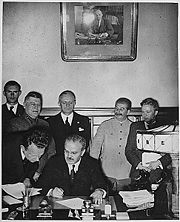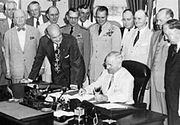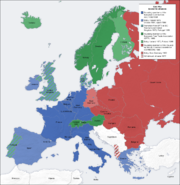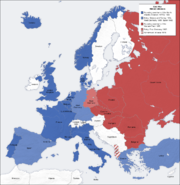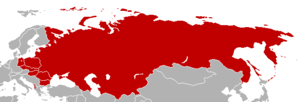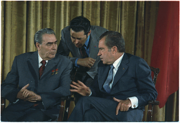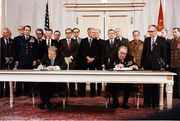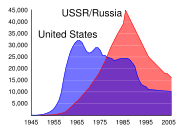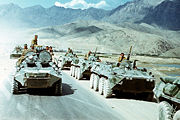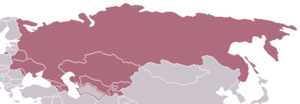Cold War
2008/9 Schools Wikipedia Selection. Related subjects: General history; Recent History
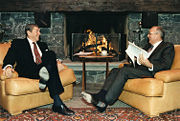
The Cold War was the period of conflict, tension and competition between the United States and the Soviet Union and their respective allies from the mid-1940s until the early 1990s. Throughout this period, the rivalry between the two superpowers unfolded in multiple arenas: military coalitions; ideology, psychology, and espionage; sports; military, industrial, and technological developments, including the space race; costly defense spending; a massive conventional and nuclear arms race; and many proxy wars.
There was never a direct military engagement between the US and the Soviet Union, but there was half a century of military buildup as well as political battles for support around the world, including significant involvement of allied and satellite nations in proxy wars. Although the US and the Soviet Union had been allied against Nazi Germany, the two sides differed on how to reconstruct the postwar world even before the end of World War II. Over the following decades, the Cold War spread outside Europe to every region of the world, as the US sought the " containment" of communism and forged numerous alliances to this end, particularly in Western Europe, the Middle East, and Southeast Asia. There were repeated crises that threatened to escalate into world wars but never did, notably the Berlin Blockade (1948–49), the Korean War (1950–53), the Vietnam War (1959–1975), the Cuban Missile Crisis (1962), and the Soviet-Afghan War (1979–89). There were also periods when tension was reduced as both sides sought détente. Direct military attacks on adversaries were deterred by the potential for mutual assured destruction using deliverable nuclear weapons.
| History of the Cold War |
|---|
| Origins |
| 1947–1953 |
| 1953–1962 |
| 1962–1979 |
| 1979–1985 |
| 1985–1991 |
| Timeline |
The Cold War drew to a close in the late 1980s following Soviet leader Mikhail Gorbachev's summit conferences with United States President Ronald Reagan, as well as Gorbachev's launching of reform programs: perestroika and glasnost.
Origins of the term
In the specific sense of the Cold War referring to the post-World War II geopolitical tensions between the Soviet Union and the United States, the term has been attributed to American financier and U.S. presidential advisor Bernard Baruch. The Cassell Companion to Quotations cites a speech Baruch gave in South Carolina, April 16, 1947 in which he said, "Let us not be deceived: we are today in the midst of a cold war." The Cassell Companion notes that the phrase was actually suggested to Baruch by his speechwriter, Herbert Bayard Swope, who had been using it privately since 1940. Columnist Walter Lippmann also gave the term wide currency after his 1947 book titled Cold War.
History
Pre-Cold War
There is some disagreement over what constitutes the beginning of the Cold War. While most historians say that it began in the period just after World War II, some say that it began towards the end of World War I, though tensions between Russian Empire/USSR and British Empire and the United States date back to the middle of the 19th century.
The ideological clash between communism and capitalism began in 1917 following the Russian Revolution, when the USSR emerged as the first major communist power. This was the first event which made Russian-American relations a matter of major, long-term concern to the leaders in each country.
Several events led to suspicion and distrust between the United States and the Soviet Union: US intervention in Russia supporting the White Army in the Russian Civil War, Russia's withdrawal from World War I in the Treaty of Brest-Litovsk with Germany, the Bolsheviks' challenge to capitalism, the US refusal to recognize the Soviet Union until 1933. Other events in the period immediately before WWII increased this suspicion and distrust. The British appeasement of Germany and the German-Soviet Non-aggression Pact are two notable examples.
World War II and Post-War (1939–47)
During the war, the Soviets strongly suspected that the Anglo-Americans had opted to let the Russians bear the brunt of the war effort, to insert themselves only at the last minute so as to influence the peace settlement and dominate Europe. Historians such as John Lewis Gaddis dispute this claim, citing other military and strategic calculations for the timing of the Normandy invasion. Nevertheless, Soviet perceptions (or misconceptions) of the West and vice versa left a strong undercurrent of tension and hostility between the Allied powers.
There was severe disagreement between the Allies about how Europe should look following the war. Both sides, moreover, held very dissimilar ideas regarding the establishment and maintenance of post-war security. The Americans tended to understand security in situational terms, assuming that, if US-style governments and markets were established as widely as possible, countries could resolve their differences peacefully, through international organizations. Soviet leaders, however, tended to understand security in terms of space. This reasoning was conditioned by Russia's historical experiences, given the frequency with which the country had been invaded over the last 150 years.
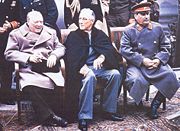
At the Yalta Conference in February 1945, the Allies attempted to define the framework for a post-war settlement in Europe but could not reach a firm consensus. Following the Allied victory in May, the Soviets effectively occupied Eastern Europe, while the US had much of Western Europe. In occupied Germany, the US and the Soviet Union established zones of occupation and a loose framework for four-power control with the ailing French and British.
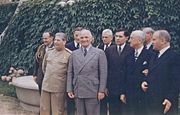
At the Potsdam Conference, starting in late July, serious differences emerged over the future development of Germany and Eastern Europe. At this conference Truman informed Stalin that the United States possessed a powerful new weapon. "Stalin’s only reply was to say that he was glad to hear of the bomb and he hoped [the United States] would use it." One week after the end of the Potsdam Conference, the atomic bombings of Hiroshima and Nagasaki led to further conflict between the Soviet Union and the United States. Shortly after the attacks, Stalin protested to US officials when Truman offered the Soviets little real influence in occupied Japan.
In February 1946, George F. Kennan's " Long Telegram" from Moscow helped to articulate the growing hard line that was being taken against the Soviets.. On September 6, 1946, James F. Byrnes made a speech in Germany, repudiating the Morgenthau Plan and warning the Soviets that the US intended to maintain a military presence in Europe indefinitely. As Byrnes admitted one month later, "The nub of our program was to win the German people [...] it was a battle between us and Russia over minds [....]" A few weeks after the release of this "Long Telegram", former British Prime Minister Winston Churchill delivered his famous "Iron Curtain" speech in Fulton, Missouri. The speech called for an Anglo-American alliance against the Soviets, whom he accused of establishing an "iron curtain" from " Stettin in the Baltic to Trieste in the Adriatic."
From "Containment" through the Korean War (1947–53)
By 1947, Truman's advisors were worried that time was running out to counter the influence of the Soviet Union. In Europe, post-war economic recovery was faltering, and shortages of food and other essential consumer goods were common. Truman's advisors feared that the Soviet Union was seeking to weaken the position of the US in a period of post-war confusion and collapse.
The event which spurred Truman on to announce formally the US's adopting the policy of " containment" was the British government's announcement in February 1947 that it could no longer afford to finance the Greek monarchical military regime in its civil war against communist-led insurgents. Rather than view this war as a civil conflict revolving around domestic issues, US policymakers interpreted it as a Soviet effort; however, the insurgents were helped by Josip Broz Tito's Yugoslavia, not Moscow. Secretary of State Dean Acheson accused the Soviet Union of conspiracy against the Greek royalists in an effort to "expand" into the Middle East, Asia, and Africa, and in March 1947 the administration unveiled the " Truman Doctrine". As Truman declared during March 1947:
| “ | It must be the policy of the United States, to support free peoples who are resisting attempted subjugation by armed minorities or outside pressures....[W]e must assist free peoples to work out their own destinies in their own way. | ” |
Truman rallied Americans in his famous "Truman Doctrine" speech to spend $400,000,000 on intervention in the civil war in Greece. In order to mobilize an unfriendly Republican Congress, the Democratic president painted the conflict as a contest between "free" peoples and "totalitarian" regimes, thus dramatically heightening the rhetorical stakes of the conflict. By aiding Greece, Truman set a precedent for US aid to regimes, no matter how repressive and corrupt, that requested help to fight communists.
Without the assistance of huge capital resources to rebuild industry transferred from the United States, Western European economies failed to recover from the enormous wartime destruction of the region's infrastructure. Communist parties, meanwhile, were winning large votes in free elections in countries such as France and Italy. American policymakers were worried that economic conditions in Western Europe might deteriorate to the point where communist parties could seize power there, too, through free elections or popular revolutions. Some US policymakers also feared that their own economy might suffer unless effective demand for their exports in Western Europe was restored.
For US policymakers, threats to Europe's balance of power were not necessarily military ones, but a political and economic challenge. George Kennan helped to summarise the problem at the State Department Planning Staff in May 1947: "Communist activities" were not "the root of the difficulties of Western Europe" but rather "the disruptive effects of the war on the economic, political, and social structure of Europe." According to this view, the Communists were "exploiting the European crisis" to gain power. In June, following the recommendations of the State Department Planning Staff, the Truman Doctrine was complemented by the Marshall Plan, a pledge of economic assistance aimed at rebuilding the Western political-economic system and countering perceived threats to Europe's balance of power, which the US had gone to war to restore, from the radical left.
After lobbying by the Joint Chiefs of Staff, and Generals Clay and Marshall, the Truman administration finally realised that economic recovery in Europe could not go forward without the reconstruction of the German industrial base on which it had previously been dependent.

In July, Truman rescinded, on "national security grounds", the punitive Morgenthau plan JCS 1067, which had directed the US forces of occupation in Germany to "take no steps looking toward the economic rehabilitation of Germany." It was replaced by JCS 1779, which stressed instead that "[a]n orderly, prosperous Europe requires the economic contributions of a stable and productive Germany."
Also in July, Truman reorganised his government to fight the Cold War. The National Security Act of 1947, signed by Truman on July 26, created a unified Department of Defense, the Central Intelligence Agency (CIA), and the National Security Council. These would become the main bureaucracies for US policy in the Cold War.
The twin policies of the Truman Doctrine and the Marshall Plan led to billions in economic and military aid to Western Europe, and Greece and Turkey. With US assistance, the Greek military won its civil war, and the Italian Christian Democrats defeated the powerful Communist- Socialist alliance in the elections of 1948.
The US consolidated its new role as leader of the West. In retaliation to Western moves to reunite West Germany, Stalin built blockades to block western access to West Berlin, but Truman maintained supply lines to the enclave by flying supplies in over the blockade from 1948 to '49.
The US formally allied itself to the Western European states in the North Atlantic Treaty of 1949, establishing the North Atlantic Treaty Organization (NATO). Stalin countered by tying together the economies of the Eastern bloc in a Soviet-led version of the Marshall Plan, the Council for Mutual Economic Assistance (COMECON), and exploding the first Soviet atomic device in August 1949.
The US took the lead in re-establishing West Germany from the three Western zones of occupation in 1949. To counter this Western reorganisation of Germany, the Soviet Union proclaimed its zone of occupation in Germany the " German Democratic Republic" in 1949. In the early 1950s, the US worked for the rearmament of West Germany and, in 1955, its full membership to NATO.
In 1949 Mao's Red Army defeated the US-backed Kuomintang regime in China. Shortly afterwards, the Soviet Union created an alliance with the newly formed People's Republic of China. Confronted with the Chinese Revolution and the end of the US atomic monopoly in 1949, the Truman administration quickly moved to escalate and expand the containment policy. In a secret 1950 document, NSC-68, Truman administration officials proposed to reinforce pro-Western alliance systems and quadruple spending on defence.
US officials moved thereafter to expand "containment" into Asia, Africa, and Latin America. At the same time, revolutionary nationalist movements, often led by Communist parties, were fighting against the restoration of Europe's colonial empires in South-East Asia. The US formalized an alliance with Japan in the early 1950s, thereby guaranteeing the United States a number of long-term military bases. Truman also brought other states, including Australia, New Zealand, Thailand and the Philippines, into a series of alliances.
One of the most significant impacts of containment was the Korean War. The US and Soviet Union had been fighting proxy wars as just mentioned, on a small scale, and without US troops; but to Stalin's surprise, Truman committed US forces to drive back the North Koreans, who had invaded South Korea. Public opinion in countries such as Great Britain, usual allies of the US, was divided for and against the war. British Attorney General Sir Hartley Shawcross repudiated the sentiment of those opposed when he said "I know there are some who think that the horror and devastation of a world war now would be so frightful, whoever won, and the damage to civilization so lasting, that it would be better to submit to Communist domination. I understand that view - but I reject it." In 1953, the Korean War ended in stalemate, but the US gradually got itself entangled in another civil war. The US supported the South Vietnamese government against North Vietnam, which was backed by the Soviet Union and China.
Crisis and escalation (1953–62)
In 1953 changes in political leadership on both sides shifted the dynamic of the Cold War. Dwight D. Eisenhower was inaugurated president in January 1953. During the last 18 months of the Truman administration, the US defence budget had quadrupled; and Eisenhower resolved to reduce military spending by brandishing the United States' nuclear superiority while continuing to fight the Cold War effectively. In March Joseph Stalin died, and the Soviets, now led by Nikita Khrushchev, moved away from Stalin's policies.
Eisenhower's secretary of state, John Foster Dulles initiated a "New Look" for the "containment" strategy, calling for a greater reliance on nuclear weapons to US enemies. Dulles also enunciated the doctrine of "massive retaliation," threatening a severe US response to any Soviet aggression. Possessing nuclear superiority, for example, Eisenhower curtailed Soviet threats to intervene in the Middle East during the 1956 Suez Crisis.
There was a slight relaxation of tensions after Stalin's death in 1953, but the Cold War in Europe remained an uneasy armed truce. US troops seemed stationed indefinitely in West Germany and Soviet forces seemed indefinitely stationed throughout Eastern Europe. To counter West German rearmament, the Soviets established a formal alliance with the Eastern European Communist states termed the Warsaw Pact Treaty Organization or Warsaw Pact in 1955. In 1956, the status quo was briefly threatened in Hungary, when the Soviets invaded rather than allow the Hungarians to move out of their orbit. Berlin remained divided and contested. In 1961, the East Germans erected the Berlin Wall to prevent the movement of East Berliners into West Berlin.
In the US, Wisconsin senator Joseph McCarthy emerged as an influential proponent of a hard-line stance on the Cold War. Although the president quietly deplored his demagoguery, the senator exploited anti-Soviet sentiment when alleging a communist conspiracy to take over the US government, leading to a massive political witch-hunt.
During the 1950s, the Third World was an increasingly important arena of Cold War competition. After the Second World War, the US emerged as the predominant power in the Third World, filling the vacuum of the old imperial hegemony of its principal Cold War allies—the traditional Western European colonial powers (particularly the UK, France, and the Netherlands). However, nationalists in many postcolonial states were often unsympathetic to the Western bloc. Adjusting to decolonization, meanwhile, was a difficult process economically and psychologically for European powers; and NATO suffered, as it included all the world's major colonial empires.
Nationalist movements in some countries and regions, notably Guatemala, Iran, the Philippines, and Indochina were often allied with communist groups—or at least were perceived in the West to be allied with communists. In this context, the US and the Soviet Union increasingly competed for influence by proxy in the Third World as decolonization gained momentum in the 1950s and early 1960s. The US government utilized the CIA in order to remove a string of unfriendly Third World governments and to support others. The US used the CIA to overthrow governments suspected by Washington of turning pro-Soviet, including Iran's first democratically elected government under Prime Minister Mohammed Mossadegh in 1953 and Guatemala's democratically-elected president Jacobo Arbenz Guzmán in 1954. Between 1954 and 1961, the US sent economic aid and military advisors to stem the collapse of South Vietnam's pro-Western regime.
Many emerging nations of Asia, Africa, and Latin America rejected the pressure to choose sides in the East-West competition. In 1955, at the Bandung Conference in Indonesia dozens of Third World governments resolved to stay out of the Cold War. The consensus reach at Bandung culminated with the creation of the Non-Aligned Movement in 1961. Meanwhile, Khrushchev broadened Moscow's policy to establish ties with India and other key neutral states. Independence movements in the Third World transformed the postwar order into a more pluralistic world of decolonized African and Middle Eastern nations and of rising nationalism in Asia and Latin America.
During the 1950s, the US and the USSR pursued nuclear rearmament and developed long-range weapons with which they could strike the territory of the other. The Soviets developed their own hydrogen bomb and, in 1957, launched the first earth satellite. However, the period after 1956 was marked by serious setbacks for the Soviet Union, most notably the breakdown of the Sino-Soviet alliance. Before Khrushchev's ousting in 1964, the Soviets focused on a bitter rivalry with Mao's China for leadership of the global communist movement.
The nuclear arms race brought the two superpowers to the brink of nuclear war. Khrushchev formed an alliance with Fidel Castro after the Cuban Revolution in 1959. In 1962, President John F. Kennedy responded to the installation of nuclear missiles in Cuba with a naval blockade—a show of force that brought the world close to nuclear war. The Cuban Missile Crisis showed that neither superpower was ready to use nuclear weapons for fear of the other's retaliation, and thus of mutually assured destruction. The aftermath of the crisis led to the first efforts at nuclear disarmament and improving relations.
From confrontation through détente (1962–79)
In the course of the 1960s and 1970s, both the US and the Soviet Union struggled to adjust to a new, more complicated pattern of international relations in which the world was no longer divided into two clearly opposed blocs by the two superpowers. Since the beginning of the postwar period, Western Europe and Japan rapidly recovered from the destruction of World War II and sustained strong economic growth through the 1950s and 1960s, increasing their strength compared to the United States. As a result of the 1973 oil crisis, combined with the growing influence of Third World alignments such as the Organization of Petroleum Exporting Countries (OPEC) and the Non-Aligned Movement, less-powerful countries had more room to assert their independence and often showed themselves resistant to pressure from either superpower. (EB) Moscow, meanwhile, was forced to turn its attention inward to deal with the Soviet Union's deep-seated domestic economic problems. During this period, Soviet leaders such as Alexei Kosygin and Leonid Brezhnev embraced the notion of détente.
Nevertheless, both superpowers resolved to reinforce their global leadership. Both the Soviet Union and the United States struggled to stave off challenges to their leadership in their own regions. President Lyndon B. Johnson landed 22,000 troops in the Dominican Republic, citing the threat of the emergence of a Cuban-style revolution in Latin America.
In Eastern Europe, the Soviets invaded Czechoslovakia during 1968, in order to crush the Prague Spring reform movement, that might have threatened to take the country out of the Warsaw Pact. The invasion sparked intense protests from Yugoslavia, Romania and China, as well as from other Western European communist parties.
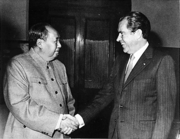
The US continued to spend heavily on supporting friendly Third World regimes in Asia. Conflicts in peripheral regions and client states—most prominently in Vietnam—continued. Johnson stationed 575,000 troops in Southeast Asia to defeat the National Front for the Liberation of South Vietnam (NLF) and their North Vietnamese allies, but his costly policy weakened the US economy and, by 1975, ultimately culminated in what most of the world saw as a humiliating defeat of the world's most powerful superpower at the hands of one of the world's poorest nations. Brezhnev, meanwhile, faced far more daunting challenges in reviving the Soviet economy, which was declining in part because of heavy military expenditures.
Although indirect conflict between Cold War powers continued through the late 1960s and early 1970s, tensions began to ease, as the period of détente began. The Chinese had sought improved relations with the US in order to gain advantage over the Soviets. In February 1972, Richard Nixon traveled to Beijing and met with Mao Zedong and Chou En-Lai. Nixon and Henry Kissinger then announced a stunning rapprochement with Mao's China.
Later, in June, Nixon and Kissinger met with Soviet leaders in Moscow, and announced the first of the Strategic Arms Limitation Talks, aimed at limiting the development of costly antiballistic missiles and offensive nuclear missiles. Between 1972 and 1974, the two sides also agreed to strengthen their economic ties. Meanwhile, these developments coincided with the " Ostpolitik" of West German Chancellor Willy Brandt. Other agreements were concluded to stabilize the situation in Europe, culminating in the Helsinki Accords signed by the Conference on Security and Co-operation in Europe in 1975.
However, the détente of the 1970s was short-lived. The US Congress limited the economic pact between Nixon and Brezhnev so much that the Soviets repudiated it in 1975. Indirect conflict between the superpowers continued through this period of détente in the Third World, particularly during political crises in the Middle East, Chile and Angola. While President Jimmy Carter tried to place another limit on the arms race with a SALT II agreement in 1979, his efforts were undercut by the other events that year, including the Iranian Revolution and the Nicaraguan Revolution, which both ousted pro-US regimes, and his retaliation against Soviet intervention in Afghanistan in December.
The "Second Cold War" (1979–85)
The term second Cold War has been used by some historians to refer to the period of intensive reawakening of Cold War tensions and conflicts in the early 1980s. Tensions greatly increased between the major powers with both sides becoming more militaristic.
During December 1979, about 75,000 Soviet troops invaded Afghanistan, in order to support the Marxist government led by Prime-minister Nur Muhammad Taraki. As a result to this, US President Jimmy Carter, withdrew the SALT II treaty from the Senate, decided to impose embargoes on grain and technology shipments to the USSR, demanded a significant increase in military spendings and further announced that the United States would boycott the 1980 Moscow Summer Olympics. Also, he described the Soviet intervention in Afghanistan as the most serious threat to the peace since the Second World War.
In 1980 Ronald Reagan defeated Jimmy Carter, vowing to increase military spending and confront the Soviets everywhere. Both Reagan and Britain's new prime minister, Margaret Thatcher, denounced the Soviet Union in ideological terms that rivaled that of the worst days of the Cold War in the late 1940s.
With the background of the build-up of tension between the Soviet Union and the United States, as well as deployment of Soviet SS-20 ballistic missiles targetting Western Europe, NATO decided, under the impetus of the Carter presidency, to deploy Pershing II and cruise missiles in Europe, primarily West Germany. This deployment would have placed missiles just 10 minutes striking distance from Moscow. Yet support for the deployment was wavering and many doubted whether the push for deployment could be sustained. But on September 1, 1983, the Soviet Union shot down Korean Air Lines Flight 007, a Boeing 747 with 269 people aboard when it violated Soviet airspace just past the west coast of Sakhalin Island—an act which Reagan characterized as a "massacre". This act, galvanized support for the deployment—which stood in place until the later accords between Reagan and Mikhael Gorbachev.
Reagan spent $2.2 trillion for the military over eight years. Military spending, combined with the legacy of the economic structural problems of the 1970s, transformed the US from the world's leading creditor in 1981 to the world's leading debtor. Tensions intensified in the early 1980s when Reagan installed US cruise missiles in Europe and announced his experimental Strategic Defense Initiative, dubed "Star Wars" by the media, to shoot down missiles in mid-flight. Reagan also imposed economic sanctions to protest the suppression of the opposition Solidarity movement in Poland.
US domestic public concerns about intervening in foreign conflicts persisted from the end of the Vietnam War. But Reagan did not encounter major public opposition to his foreign policies. The Reagan administration emphasized the use of quick, low cost counterinsurgency tactics to intervene in foreign conflicts. In 1983, the Reagan administration intervened in the multisided Lebanese Civil War, invaded Grenada, bombed Libya and backed the Central American Contras—right-wing paramilitaries seeking overthrow the Soviet-aligned Sandinista government in Nicaragua. While Reagan's interventions against Grenada and Libya were popular in the US, his backing of the Contra rebels was mired in controversy. In 1985, the president authorized the sale of arms to Iran; later, administration subordinates illegally diverted the proceeds to the Contras.
Meanwhile, the Soviets incurred high costs for their own foreign interventions. Although Brezhnev was convinced in 1979 that the Soviet war in Afghanistan would be brief, Muslim guerrillas, aided by the USA, waged a surprisingly fierce resistance against the invasion. The Kremlin sent nearly 100,000 troops to support its puppet regime in Afghanistan, leading many outside observers to call the war the Soviets' Vietnam. However, Moscow's quagmire in Afghanistan was far more disastrous for the Soviets than Vietnam had been for the Americans because the conflict coincided with a period of internal decay and domestic crisis in the Soviet system. A high US State Department official predicted such an outcome as early as 1980, positing that the invasion resulted in part from a "domestic crisis within the Soviet system....It may be that the thermodynamic law of entropy has...caught up with the Soviet system, which now seems to expend more energy on simply maintaining its equilibrium than on improving itself. We could," he construed, "be seeing a period of foreign movement at a time of internal decay."
End of the Cold War
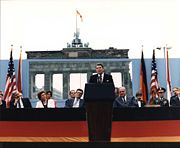
By the early 1980s, the Soviet armed forces were the largest in the world by many measures—in terms of the numbers and types of weapons they possessed, in the number of troops in their ranks, and in the sheer size of their military-industrial base. However, the quantitative advantages held by the Soviet military often concealed areas where the Eastern bloc dramatically lagged behind the West. This led many US observers to vastly overestimate Soviet power.
By the late years of the Cold War, Moscow had built up a military that consumed as much as twenty-five percent of the Soviet Union's gross national product at the expense of consumer goods and investment in civilian sectors. But the size of the Soviet armed forces was not necessarily the result of a simple action-reaction arms race with the United States (Odom). Instead, Soviet spending on the arms race and other Cold War commitments can be understood as both a cause and effect of the deep-seated structural problems in the Soviet system, which accumulated at least a decade of economic stagnation during the Brezhnev years. Soviet investment in the defence sector was not necessarily driven by military necessity, but in large part by the interests of massive party and state bureaucracies dependent on the sector for their own power and privileges .
By the time Mikhail Gorbachev had ascended to power in 1985, the Soviets suffered from an economic growth rate close to zero percent, combined with a sharp fall in hard currency earnings as a result of the downward slide in world oil prices in the 1980s. (Petroleum exports made up around 60 percent of the Soviet Union's total export earnings.) To restructure the Soviet economy before it collapsed, Gorbachev announced an agenda of rapid reform. Reform required Gorbachev to redirect the country's resources from costly Cold War military commitments to more profitable areas in the civilian sector. As a result, Gorbachev offered major concessions to the United States on the levels of conventional forces, nuclear weapons, and policy in Eastern Europe.
| Comparison between USSR and US economies (1989) according to 1990 CIA The World Factbook |
||
|---|---|---|
| USSR | US | |
| GDP (1989 - millions $) | 2,659,500 | 5,233,300 |
| Population (July 1990) | 290,938,469 | 250,410,000 |
| GDP Per Capita ($) | 9,211 | 21,082 |
| Labor force (1989) | 152,300,000 | 125,557,000 |
Many US Soviet experts and administration officials doubted that Gorbachev was serious about winding down the arms race but the new Soviet leader eventually proved more concerned about reversing the Soviet Union's deteriorating economic condition than fighting the arms race with the West.
The Kremlin made major military and political concessions; in response Reagan agreed to renew talks on economic issues and the scaling-back of the arms race. The East-West tensions that had reached intense new heights earlier in the decade rapidly subsided through the mid-to-late 1980s. In 1988, the Soviets officially declared that they would no longer intervene in the affairs of allied states in Eastern Europe—the so-called Sinatra Doctrine. In 1989, Soviet forces withdrew from Afghanistan.
In December 1989, Gorbachev and George H.W. Bush declared the Cold War officially over at a summit meeting in Malta. But by then, the Soviet alliance system was on the brink of collapse, and the Communist leaders of the Warsaw Pact states were losing power. In the USSR itself, Gorbachev tried to reform the party to destroy resistance to his reforms, but, in doing so, ultimately weakened the bonds that held the state and union together. By February 1990, the Communist Party was forced to surrender its 73-year old monopoly on state power. By December of the next year, the union-state also dissolved, breaking the USSR up into fifteen separate independent states.
Legacy
The Cold War was fought at a tremendous cost globally over the course of more than four decades. It cost the U.S. up to $8 trillion in military expenditures, and the lives of nearly 100,000 Americans in Korea and Vietnam. It cost the Soviets an even higher share of their gross national product. In Southeast Asia, local civil wars were intensified by superpower rivalry, leaving millions dead.
After the dissolution of the Soviet Union, the post-Cold War world is widely considered as a unipolar world, with the United States as the world's sole remaining superpower. In the words of Samuel P. Huntington, "The United States, of course, is the sole state with preeminence in every domain of power — economic, military, diplomatic, ideological, technological, and cultural — with the reach and capabilities to promote its interests in virtually every part of the world."
The newly created Commonwealth of Independent States on December 21, 1991, could be viewed as a successor entity to the Soviet Union and, according to leaders of Russia, its purpose was to "allow a civilized divorce" between the Soviet Republics. However, the CIS is emphatically not a state unto itself, and is more comparable to a loose confederation, similar to the European Community.
The end of the Cold War gave Russia the chance to cut military spending dramatically, but the adjustment was wrenching. The military-industrial sector employed at least one of every five Soviet adults. Its dismantling left millions throughout the former Soviet Union unemployed. Russian living standards have worsened overall in the post-Cold War years, although the economy has resumed growth in recent years. In the 1990s, Russia suffered an economic downturn more severe than the U.S. or Germany had undergone six decades earlier in the Great Depression after it had embarked on capitalist economic reforms.
The legacy of the Cold War continues to structure world affairs. The Cold War institutionalized the role of the United States in the postwar global economic and political system. By 1989, the U.S. was responsible for military alliances with 50 countries and 1.5 million US troops were posted in 117 countries. The Cold War also institutionalized the commitment to a huge, permanent wartime military-industrial complex.
Some of the economic and social tensions that underpinned Cold War competition in parts of the Third World remain acute. The breakdown of state control in a number of areas formerly ruled by Communist governments has produced new civil and ethnic conflicts, particularly in the former Yugoslavia. In some countries, the breakdown of state control was accompanied by state failure, such as in Afghanistan. But in other areas, particularly much of Eastern Europe, the end of the Cold War was accompanied by a large growth in the number of liberal democracies. In areas where the two superpowers had been waging proxy wars, and subsidizing local conflicts, many conflicts ended with the Cold War; and the occurrence of interstate wars, ethnic wars, revolutionary wars, or refugee and displaced persons crises declined sharply.
Historiography
As soon as the term "Cold War" was popularized to refer to postwar tensions between the United States and the Soviet Union, interpreting the course and origins of the conflict has been a source of heated controversy among historians, political scientists, and journalists. In particular, historians have sharply disagreed as to who was responsible for the breakdown of Soviet-U.S. relations after the Second World War; and whether the conflict between the two superpowers was inevitable, or could have been avoided. Historians have also disagreed on what exactly the Cold War was, what the sources of the conflict were, and how to disentangle patterns of action and reaction between the two sides.
While the explanations of the origins of the conflict in academic discussions are complex and diverse, several general schools of thought on the subject can be identified. Historians commonly speak of three differing approaches to the study of the Cold War: "orthodox" accounts, "revisionism," and "post-revisionism." Nevertheless, much of the historiography on the Cold War weaves together two or even all three of these broad categories.
Orthodox accounts
The first school of interpretation to emerge in the U.S. was the "orthodox" one. For more than a decade after the end of the Second World War, few U.S. historians challenged the official U.S. interpretation of the beginnings of the Cold War. This "orthodox" school places the responsibility for the Cold War on the Soviet Union and its expansion into Eastern Europe. Thomas A. Bailey, for example, argued in his 1950 America Faces Russia that the breakdown of postwar peace was the result of Soviet expansionism in the immediate postwar years. Bailey argued Stalin violated promises he had made at Yalta, imposed Soviet-dominated regimes on unwilling Eastern European populations, and conspired to spread communism throughout the world. From this view, U.S. officials were forced to respond to Soviet aggression with the Truman Doctrine, plans to contain communist subversion around the world, and the Marshall Plan.
This interpretation has been described as the "official" U.S. version of Cold War history. Although it lost its dominance as a mode of historical thought in academic discussions in 1960s, it continues to be influential.
Revisionism
U.S. involvement in Vietnam in the 1960s disillusioned many historians with the premise of "containment", and thus with the assumptions of the "orthodox" approach to understanding the Cold War. "Revisionist" accounts emerged in the wake of the Vietnam War, in the context of a larger rethinking of the U.S. role in international affairs, which was seen more in terms of American empire or hegemony.
The Wisconsin school of interpretation argues that the U.S. and the U.S.S.R. were economic rivals, making them natural adversaries, irrespective of their ideologies. Walter LaFeber, meanwhile, argues the U.S. and Imperial Russia were already rivals by 1900 over the development of Manchuria. Russia, unable to compete industrially with the States, sought to close off parts of East Asia to trade with other colonial powers. Meanwhile, the U.S. demanded open competition for markets.
While the new school of thought spanned many differences among individual scholars, the works comprising it were generally responses in one way or another to William Appleman Williams' landmark 1959 volume, The Tragedy of American Diplomacy. Williams challenged the long-held assumptions of "orthodox" accounts, arguing that Americans had always been an empire-building people, even while American leaders denied it.
Following Williams, "revisionist" writers placed more responsibility for the breakdown of postwar peace on the United States, citing a range of U.S. efforts to isolate and confront the Soviet Union well before the end of World War II. According to Williams and later "revisionist" writers, U.S. policymakers shared an overarching concern with maintaining capitalism domestically. In order to achieve that objective, they pursued an " open door" policy abroad, aimed at increasing access to foreign markets for U.S. business and agriculture. From this perspective, a growing economy domestically went hand-in-hand with the consolidation of U.S. power internationally.
"Revisionist" scholars challenged the widely accepted notion that Soviet leaders were committed to postwar "expansionism". They cited evidence that the Soviet Union's occupation of Eastern Europe had a defensive rationale, and that Soviet leaders saw themselves as attempting to avoid encirclement by the United States and its allies. In this view, the Soviet Union was so weak and devastated after the end of the Second World War as to be unable to pose any serious threat to the United States; moreover, the U.S. maintained a nuclear monopoly until the U.S.S.R. tested its first atomic bomb in August 1949.
Revisionist historians have also challenged the assumption that the origins of the Cold War date no further back than the immediate postwar period. Notably, Walter LaFeber, in his landmark study, America, Russia, and the Cold War, first published in 1972, argued that the Cold War had its origins in 19th century conflicts between Russia and America over the opening of East Asia to U.S. trade, markets, and influence. LaFeber argued that the U.S. commitment at the close of World War II to ensuring a world in which every state was open to U.S. influence and trade underpinned many of the conflicts that triggered the beginning of the Cold War.
Starting with Gar Alperovitz, in his influential Atomic Diplomacy: Hiroshima and Potsdam (1965), "revisionist" scholars have focused on the U.S. decision to use atomic weapons against Hiroshima and Nagasaki during the last days of World War II. In their view, the nuclear bombing of Nagasaki and Hiroshima, in effect, started the Cold War. According to Alperovitz, the bombs were not used on an already defeated Japan to win the war, but to intimidate the Soviets, signaling that the U.S. would use nuclear weapons to structure a postwar world around U.S. interests as U.S. policymakers saw fit. According to some revisionists, Japan had tried to surrender for several months, but the U.S. wanted to test nuclear weapons in war and, most importantly, show its power to the Soviet Union.
Joyce and Gabriel Kolko's The Limits of Power: The World and U.S. Foreign Policy, 1945–1954 (1972) has also received considerable attention in the historiography on the Cold War. The Kolkos argued U.S. policy was both reflexively anticommunist and counterrevolutionary. The U.S. was not necessarily fighting Soviet influence, but any form of challenge to the U.S. economic and political prerogatives through either covert or military means. In this sense, the Cold War is less a story of rivalry between two blocs, and more a story of the ways by which the dominant states within each bloc controlled and disciplined their own populations and clients, and about who supported and stood to benefit from increased arms production and political anxiety over a perceived external enemy.
Post-revisionism
The "revisionist" interpretation produced a critical reaction of its own. In a variety of ways, "post-revisionist" scholarship, before the fall of Communism, challenged earlier works on the origins and course of the Cold War.
During the period, "post-revisionism" challenged the "revisionists" by accepting some of their findings but rejecting most of their key claims. Particularly, post-revisionist historians argued that revisionists put too much emphasis on U.S. economic considerations while ignoring domestic politics and perceptions held at the time. Another current attempted to strike a balance between the "orthodox" and "revisionist" camps, identifying areas of responsibility for the origins of the conflict on both sides. Thomas G. Paterson, in Soviet-American Confrontation (1973), for example, viewed Soviet hostility and U.S. efforts to dominate the postwar world as equally responsible for the Cold War.
The seminal work of this approach was John Lewis Gaddis's The United States and the Origins of the Cold War, 1941–1947 (1972). The account was immediately hailed as the beginning of a new school of thought on the Cold War claiming to synthesize a variety of interpretations. Gaddis then maintained that "neither side can bear sole responsibility for the onset of the Cold War." He did, however, emphasize the constraints imposed on U.S. policymakers due to the complications of domestic politics. Gaddis has, in addition, criticized some "revisionist" scholars, particularly Williams, for failing to understand the role of Soviet policy in the origins of the Cold War.
Out of the "post-revisionist" literature emerged a new area of inquiry that was more sensitive to nuance and interested less in the question of who started the conflict than in offering insight into U.S. and Soviet actions and perspectives. From this perspective, the Cold War was not so much the responsibility of either side, but rather the result of predictable tensions between two world powers that had been suspicious of one another for nearly a century. For example, Ernest May wrote in a 1984 essay:
After the Second World War, the United States and the Soviet Union were doomed to be antagonists.... There probably was never any real possibility that the post-1945 relationship could be anything but hostility verging on conflict... Traditions, belief systems, propinquity, and convenience ... all combined to stimulate antagonism, and almost no factor operated in either country to hold it back.
From this view of "post-revisionism" emerged a line of inquiry that examines how Cold War actors perceived various events, and the degree of misperception involved in the failure of the two sides to reach common understandings of their wartime alliance and their disputes.
While Gaddis does not hold either side entirely responsible for the onset of the conflict, he has now argued that the Soviets should be held clearly more accountable for the ensuing problems. According to Gaddis, Stalin was in a much better position to compromise than his Western counterparts, given his much broader power within his own regime than Truman, who was often undermined by vociferous political opposition at home. Asking if it were possible to predict that the wartime alliance would fall apart within a matter of months, leaving in its place nearly a half century of cold war, Gaddis wrote in a 1997 essay, We Now Know: Rethinking Cold War History:
Geography, demography, and tradition contributed to this outcome but did not determine it. It took men, responding unpredictably to circumstances, to forge the chain of causation; and it took [Stalin] in particular, responding predictably to his own authoritarian, paranoid, and narcissistic predisposition, to lock it into place.
For Stalin, Gaddis continues:
World politics was an extension of Soviet politics, which was in turn an extension of Stalin's preferred personal environment: a zero-sum game, in which achieving security for himself, his regime, his country and his ideology meant depriving everyone else of it.
